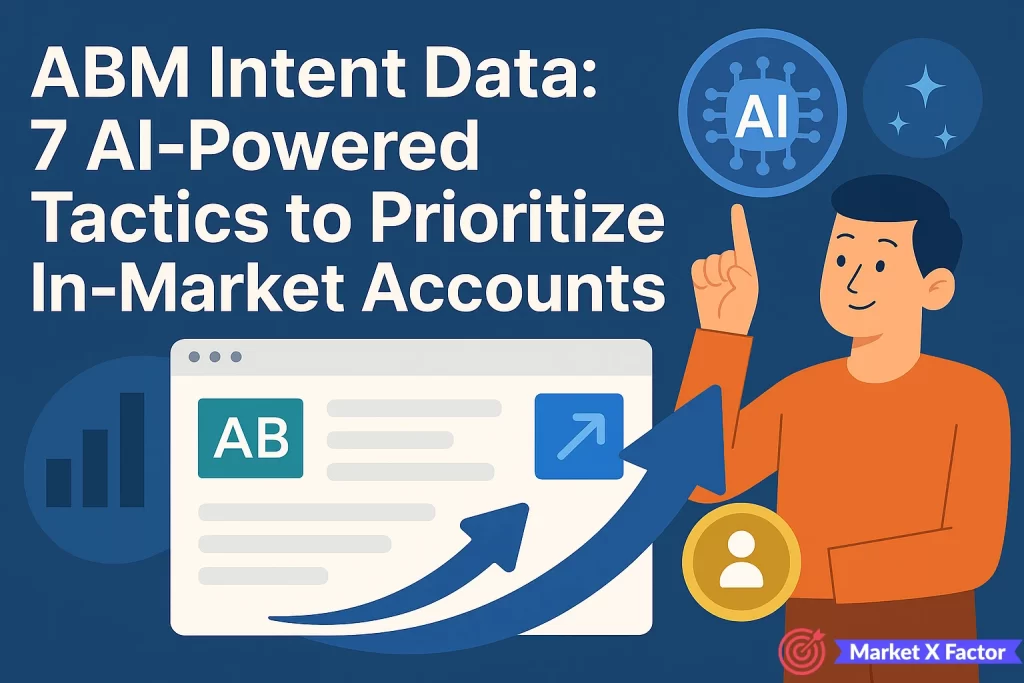
Are you maximizing ABM intent data to identify which accounts are actively researching your solutions right now?
With 70% of marketers running active ABM programs and 84% using AI for ABM intent data for personalization, the game has changed. Traditional account-based marketing relied on guesses about interested companies. Today’s AI-powered ABM intent data eliminates guesswork entirely.
The ABM market will reach $1.4 billion by 2025. AI-powered solutions drive this growth. Companies using AI in ABM strategies are 2.5 times more likely to see revenue increases. The difference? They focus resources on accounts showing purchase intent rather than hoping random outreach works.
Here’s how AI transforms your ABM intent data strategy. Before we jump into the the seven tactics, let’s first answer what is abm intent data, the types of abm intent data and how AI enhances intent signals.
What Is AI-Powered ABM Intent Data?
ABM intent data uses AI to capture digital signals revealing when companies actively research your solution category, showing which target accounts research your solution based on online behavior including what they search for, read, or engage with.
The AI advantage solves three problems:
AI amplifies this by interpreting buyer behavior in real time. Modern platforms like 6sense analyze billions of data points. They predict where accounts are in their buying journey with remarkable accuracy. Demandbase tracks over 2 trillion signals monthly using AI. This identifies accounts actively researching topics related to your product or service.
- Manual data stitching across platforms
- Noise filtering from irrelevant signals
- Delayed insights that miss optimal engagement windows
AI-native ABM platforms automate data aggregation. They provide scored recommendations for immediate action.
Types of ABM Intent Data with AI
Understanding ABM intent data categories helps build comprehensive buyer intelligence:
- First-Party ABM Intent Data
- Orginates from your owned properties. Website visits, content downloads, pricing page views, and email engagement provide direct behavioral signals. AI enhances this by identifying patterns across anonymous visitors. It predicts conversion likelihood.
- Orginates from your owned properties. Website visits, content downloads, pricing page views, and email engagement provide direct behavioral signals. AI enhances this by identifying patterns across anonymous visitors. It predicts conversion likelihood.
- Second-Party ABM Intent Data
- Emerges from partner ecosystems. Examples include accounts spending time on your partner’s website reading about similar solutions. Prospects downloading whitepapers you co-published with third-party research firms also qualify. AI correlates these signals with your first-party data for unified AI predictive account scoring.
- Emerges from partner ecosystems. Examples include accounts spending time on your partner’s website reading about similar solutions. Prospects downloading whitepapers you co-published with third-party research firms also qualify. AI correlates these signals with your first-party data for unified AI predictive account scoring.
- Third-Party ABM Intent Data
- Aggregates behavioral signals across the web. Bombora pioneered this approach with their data cooperative. It includes over 4,000 B2B websites, publications, and communities. Their Company Surge scoring uses AI to measure content consumption against historical baselines. This spots when organizations research topics at unusually high rates.
AI unifies these data types through machine learning models. These find correlations humans miss. The result? Previously hidden buying signals emerge from seemingly unrelated activities across multiple touch points.
AI-Powered Tools for ABM Intent Data Comparison
| Platform | AI Capability | Intent Data Strength | Best For |
|---|---|---|---|
| 6sense | Predictive analytics + buyer journey mapping | 500+ billion monthly signals | Enterprise ABM with complex sales cycles |
| Demandbase | AI-powered qualification scoring | 2+ trillion monthly signals, 133 languages | Global ABM campaigns with diverse markets |
| Bombora | Company Surge algorithm | 4,000+ B2B publisher network | Mid-market teams wanting proven intent data |
| ZoomInfo | Champion moves tracking | Contact + company data integration | Sales-focused teams needing contact discovery |
| G2 Buyer Intent | Software review behavior analysis | Bottom-funnel purchase signals | Software companies tracking competitive research |
1. ABM Intent Account Prioritization
ABM intent account prioritization solves the critical problem of sales teams wasting time on accounts that aren’t ready to buy, while competitors capture actively researching prospects. Traditional ABM relies on demographic guesswork, leading to poor timing and low conversion rates.
AI-powered intent prioritization transforms this by targeting accounts based on actual research behavior, including their searches, content consumption, and solution evaluations.
This approach delivers precision targeting that focuses only on accounts showing genuine buying signals, perfect timing that engages prospects when they’re actively researching and significantly higher conversion rates with sales teams reporting 40% better results when prioritizing based on intent signals.
Here’s what intent-driven prioritization unlocks for your ABM program:
- Precision targeting – Focus only on accounts showing genuine buying signals.
- Perfect timing – Engage prospects when they’re actively researching, not randomly.
- Higher conversion rates – Sales teams report 40% better conversion when prioritizing based on intent signals.
- Accelerated pipeline – Teams using intent prioritization generate $7.2M influenced pipeline with 927% ROI.
- Eliminated false signals – Stop chasing prospects who aren’t ready to buy.
A Forrester study found Demandbase customers achieve 367% ROI over three years with close to $1 million in revenue increases while SAP Concur demonstrated the power by achieving 52% increase in closed-won revenue, 57% improvement in deal size, and 59% increase in pipeline after consistently targeting prioritized accounts for just 3-4 months.
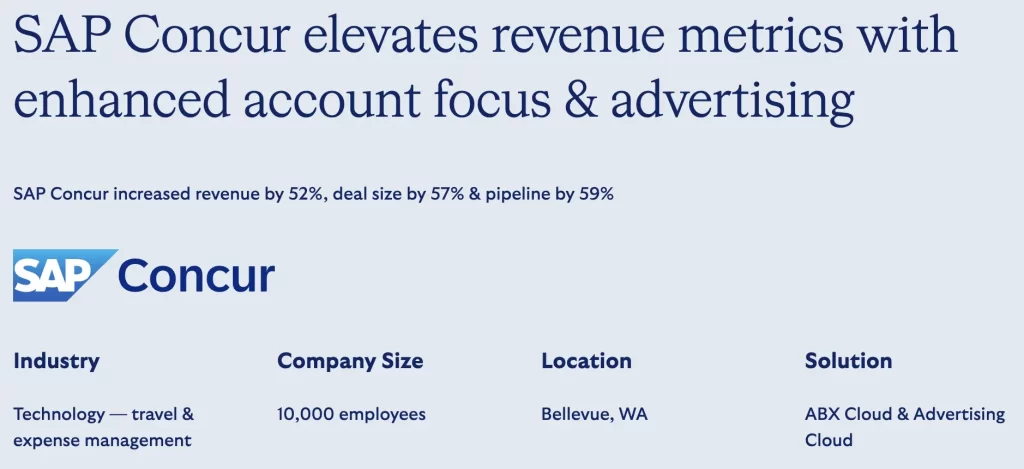
2. Real-Time Intent Surge Detection
Real-time ABM intent surge detection addresses the critical problem that 70% of buying opportunities are missed because teams rely on manual intent data reviews instead of automated detection systems.
While competitors receive instant alerts when target accounts enter buying mode, traditional approaches involve checking dashboards weekly, meaning prospects have already engaged multiple vendors by the time research spikes are discovered.
AI-powered ABM intent platforms revolutionize this by automatically monitoring target account lists for sudden research surges, delivering instant notifications when buying committees begin intensive solution evaluation.
Here’s what AI-driven real-time intent surge delivers:
- Automated surge alerts – AI detects intent spikes across your entire ABM target list instantly.
- Multi-stakeholder detection – Identify when entire buying committees enter research mode simultaneously.
- Predictive timing – Machine learning predicts optimal engagement windows based on intent velocity.
- Account scoring automation – AI continuously updates intent scores without manual intervention.
- Cross-platform monitoring – Automated tracking across websites, content hubs, and competitor research.
Qualified’s AI intent system detected a target account’s marketing team researching “ABM platform integration” across 15 different sources in 48 hours. Automated alerts triggered immediate sales outreach, resulting in a $240K deal closed in 30 days. The AI identified buying committee urgency that manual reviews would have missed entirely.

3. AI-Powered Content Personalization Based on Intent Clusters
AI-Powered content personalization based on intent clusters transforms generic messaging into hyper-relevant communications by using AI to analyze intent patterns and identify content themes that resonate with each target account.
Instead of one-size-fits-all content, this approach leverages intent data to reveal the exact topics and keywords prospects are actively researching, enabling marketers to craft highly personalized messages that speak directly to current interests and pain points.
When prospects research “cybersecurity compliance,” they automatically receive content focused on that specific topic rather than generic product features, creating experiences that feel tailored and timely.
Here’s what AI-powered ABM intent content personalization delivers:
- Dynamic content matching – AI automatically aligns messaging with specific topics each account is actively researching.
- Intent-driven segmentation – Machine learning clusters accounts based on research patterns to deliver hyper-relevant content experiences.
- Real-time content adaptation – AI updates email copy, landing pages, and ads instantly when account intent signals change.
- Multi-touchpoint personalization – Automated content customization across email, web, social, and display campaigns simultaneously.
- Behavioral content triggers – AI identifies research momentum shifts and automatically serves progressive content that matches buying stage evolution.
Marketo demonstrated this power when their demand generation team used Bombora’s Company Surge intent data to identify accounts researching “marketing automation” topics, then created targeted email segments and LinkedIn campaigns around those specific research interests.
By clustering intent topics to build audience segments and matching message content directly to what prospects were actively researching, they achieved a remarkable 107% improvement in email open rates and 120% increase in click-through rates compared to standard audiences, proving that relevance drives engagement when content aligns with genuine buyer interest.
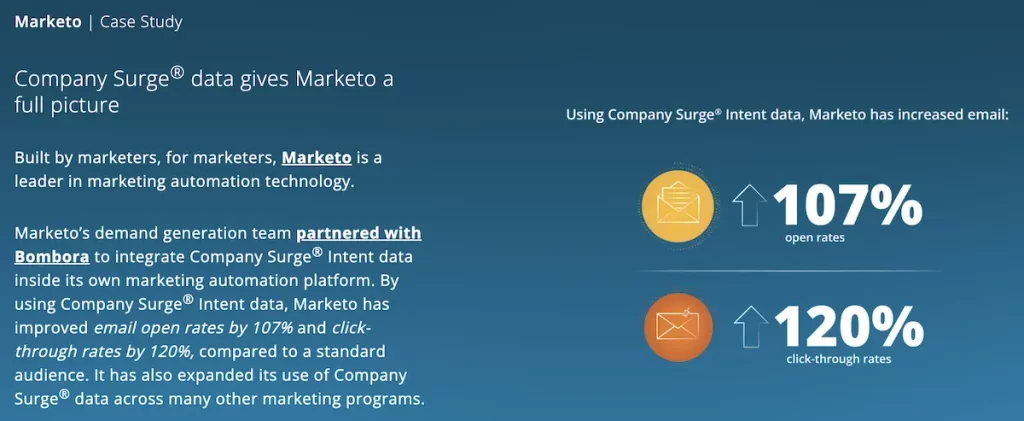
4. Campaign Orchestration with AI Agents
Cross-channel ABM campaign orchestration with AI Agents revolutionizes how marketing teams coordinate messaging across email, ads, social media, and direct mail by deploying AI agents that automatically synchronize campaigns based on intent signals.
Instead of manually managing separate channel campaigns, AI agents intelligently orchestrate messaging and timing across all touchpoints, ensuring prospects receive consistent, relevant communications regardless of where they encounter your brand.
This approach eliminates the traditional problem of disjointed messaging and poor timing coordination between channels. AI agents monitor intent data continuously and automatically trigger coordinated sequences when accounts show buying signals, adapting content and frequency based on engagement patterns.
Here’s what AI-driven cross-channel ABM campaign orchestration delivers:
- Synchronized messaging coordination – AI agents automatically align content and timing across email, ads, social media, and direct mail simultaneously.
- Intent-triggered campaign sequences – Machine learning detects buying signals and instantly launches coordinated multi-channel campaigns without manual intervention.
- Dynamic channel optimization – AI continuously adjusts message frequency and channel mix based on account engagement patterns and response data.
- Unified buyer journey management – Automated orchestration ensures prospects receive consistent, progressive messaging regardless of touchpoint interaction order.
- Cross-channel performance optimization – AI agents automatically shift budget and focus to highest-performing channels while maintaining message consistency across all touchpoints.
Salesforce demonstrated this power by using Bombora’s intent data to identify accounts researching their solutions, then building synchronized campaigns across digital display, paid social, and direct outreach. The coordinated approach ensured prospects encountered consistent messaging whether through LinkedIn ads, website visits, or sales emails, resulting in 271% ROI for digital campaigns and 33% shorter sales cycles. This proves that AI-driven orchestration creates seamless buyer experiences that significantly outperform isolated channel efforts.
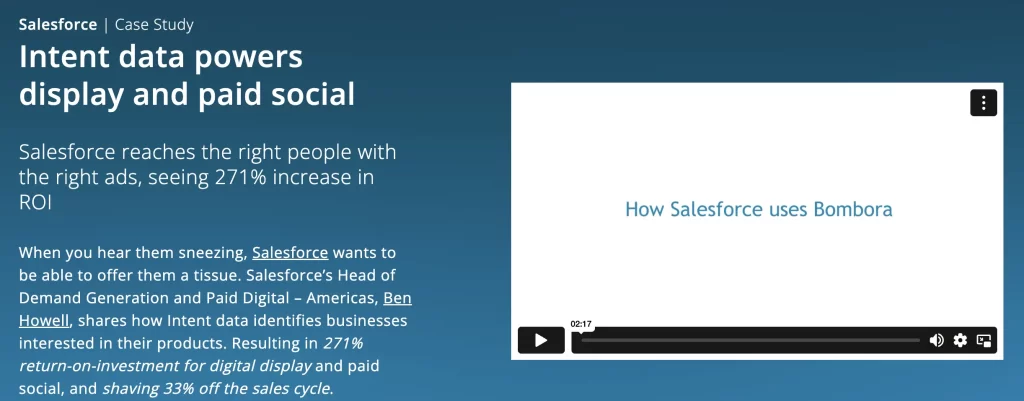
5. Predictive Account Discovery
Predictive ABM account discovery beyond your TAM up levels prospecting by using AI to identify net-new accounts showing intent signals that match your ideal customer profile patterns, expanding reach far beyond traditional target lists.
While most ABM programs focus only on known good-fit accounts, AI algorithms analyze intent patterns from successful customers to discover previously unknown prospects based on their active research behavior.
This approach uncovers entire market segments displaying similar buying signals to your best customers, revealing opportunities that would otherwise remain invisible. The AI continuously scans intent data feeds to identify accounts exhibiting research patterns matching your successful customer profiles, even when these prospects fall outside conventional demographic criteria.
Here’s what AI-driven predictive ABM account discovery delivers:
- Pattern recognition expansion – AI analyzes successful customer intent behaviors to identify similar signals in previously unknown accounts automatically.
- Market segment discovery – Machine learning uncovers entire new target markets showing research patterns matching your best customers.
- Behavioral lookalike modeling – AI continuously scans intent data feeds to find accounts exhibiting buying signals identical to high-value conversions.
- TAM expansion automation – Predictive algorithms automatically expand total addressable market beyond traditional demographic constraints using intent intelligence.
- Net-new pipeline generation – AI identifies hidden prospects actively researching your solutions outside conventional target account lists and ICP parameters.
A 6sense customer demonstrated this power by discovering 1,200 net-new high-intent accounts that weren’t on their original target list, generating 1,000 qualified leads within 2-3 months and accumulating $18M in net-new pipeline during the first four months. The predictive discovery revealed entire market segments showing similar research patterns to their best customers, proving that AI-driven account discovery can dramatically expand qualified pipeline by 20-35% beyond traditional target account approaches.
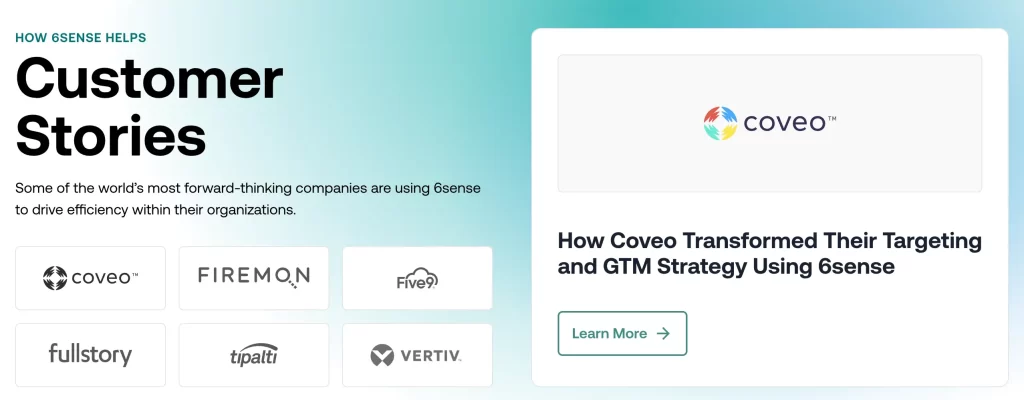
6. AI-Enhanced Sales and Marketing Alignment
AI-Enhanced ABM sales and marketing alignment eliminates destructive team silos by providing unified, AI-interpreted intent insights that both sales and marketing can act on immediately, creating seamless coordination around target accounts.
Traditional misalignment occurs when teams work from different data sources and operate on conflicting priorities, leading to inconsistent messaging and missed opportunities. AI-powered intent data solves this by delivering a single source of truth that both teams can access simultaneously, ensuring coordinated engagement strategies based on real-time buying signals.
The unified approach enables automated lead routing, shared account scoring, and synchronized outreach timing that maximizes conversion potential.
AVEVA exemplified this transformation while managing over 200 industrial software products across complex enterprise accounts. After implementing Demandbase’s ABM platform, they created unified dashboards showing intent signals, account engagement, and buying stage indicators accessible to both sales development reps and marketing teams.
This real-time data sharing enabled automated lead routing based on intent scores and account fit, allowing AVEVA to deliver tailored campaigns, reduce manual processes, and provide actionable insights that resulted in stronger coordination across multiple regional teams and product lines, proving unified intent data creates unprecedented team alignment.
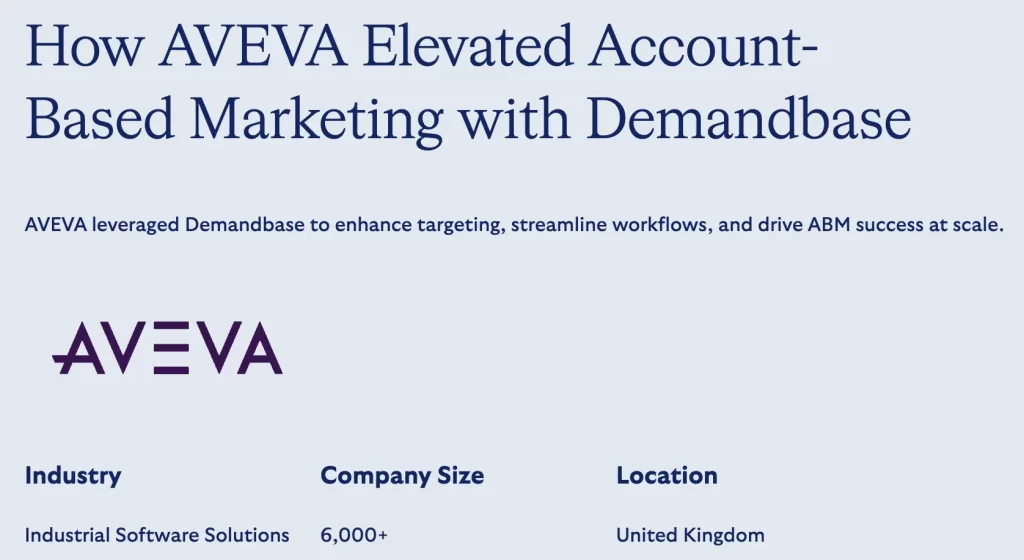
7. Dynamic Intent-Based Lead Scoring and Routing
Dynamic ABM intent-based lead scoring and routing upgrades qualification by replacing static demographic scoring with AI models that update continuously as intent signals evolve, ensuring leads are prioritized based on current buying behavior rather than outdated criteria.
Traditional lead scoring assigns fixed point values to actions like form fills or page visits, but AI-driven scoring adapts weightings based on actual conversion outcomes and changing buyer patterns, creating a living qualification system that improves over time.
This dynamic approach prioritizes accounts showing genuine research momentum rather than relying on company size or industry assumptions that often mislead sales teams toward unqualified prospects.
The AI continuously learns from successful conversions, automatically adjusting scoring algorithms to reflect what actually drives revenue rather than theoretical frameworks.
A major marketing automation software company demonstrated this power by uploading 10,000 companies showing G2 buyer intent into LinkedIn targeting, achieving 85% match rates and reaching 1 million professionals. Their dynamic scoring prioritized accounts based on real-time research activity and comparison behavior rather than demographics, generating 200 qualified leads and over $100,000 in Q4 revenue with dramatically higher conversion rates than traditional routing methods.

Mistakes to Avoid with AI in Intent Data
Over-relying on black-box algorithms without understanding signal quality leads to chasing false positives. Always validate AI recommendations with human judgment during initial implementation.
Ignoring data quality undermines AI effectiveness. Ensure your AI models are trained on accurate, recent data and establish feedback loops to improve prediction accuracy over time.
Failing to align intent signals with your actual ICP results in pursuing accounts that show research activity but lack budget, authority, or genuine need. AI amplifies targeting precision, but only when trained on your specific success patterns.
Neglecting privacy compliance creates legal risks. Third-party intent data may have compliance issues, so work with providers who maintain GDPR and CCPA compliance standards.
Frequently asked Questions about ABM Intent Data
Traditional ABM uses static target lists and manual research. AI-powered ABM intent data analyzes real-time behavioral signals automatically, identifying actively researching accounts and predicting conversion likelihood. This eliminates guesswork and enables precise engagement timing.
AI platforms achieve 85-90% accuracy in predicting buying intent when properly trained. Companies using AI in ABM strategies are 2.5 times more likely to see revenue increases. Success requires combining multiple signal sources and continuous algorithm refinement.
Demandbase tracks 2+ trillion monthly signals, 6sense analyzes 500+ billion signals monthly, and Bombora offers 4,000+ B2B publisher network coverage. The best choice depends on your target market, integration needs, and budget requirements.
AI platforms monitor intent signals in real-time, detecting and scoring changes within minutes of behavioral activity. Teams typically see 75% faster response times compared to manual monitoring, enabling immediate engagement with high-intent accounts.
ABM strategies increase revenue up to 208%. AI amplifies results with 40-60% better lead qualification, 30% higher conversion rates from intent-driven accounts, and 66% cost reduction per opportunity through automated prioritization and targeting.
